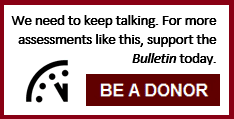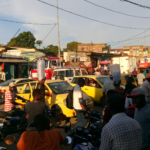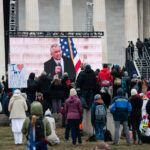A message from Tripoli, Part 3: How Libya gave up its WMD
By William Tobey | December 5, 2014

Part 3: What do you do with a plastic shopping bag full of nuclear weapon designs?
Editor's note: This is the third installment of a five-part series exploring the painstaking diplomacy and intelligence efforts that led Libya and its quixotic leader, Muammar al-Qaddafi, to relinquish that country's weapons of mass destruction. The first, second, and fourth parts of the series can be found here, here, and here, respectively.
Afraid that Col. Qaddafi might change his mind, even after having publicly renounced his country's weapons of mass destruction, senior US officials rushed to move sensitive nuclear equipment and material out of Libya. Although the mission would involve many different government agencies, its coordination fell to the State Department, and specifically to John Bolton, then the undersecretary of state for arms control and nonproliferation policy, and his assistant secretary, Paula DeSutter, who was in charge of verification and compliance issues. Together with Bob Joseph, they selected Donald Mahley, a former Army colonel who was a deputy assistant secretary in the State Department’s Nonproliferation Bureau, as the team leader in Libya.
Over the Christmas holidays of 2003, a team of experts assembled by DeSutter pieced together an emergency plan for dismantling Libya’s programs; it would require help from many agencies. While State had the lead, the Pentagon would airlift the most sensitive equipment out of Libya, and the Defense Threat Reduction Agency would oversee destruction of Libya’s highly lethal chemical munitions and ballistic missiles and consolidation of the chemical agents at secure a secure facility. The National Nuclear Security Administration would weigh in on nuclear dismantlement issues, given its unsurpassed knowledge of nuclear weapons-related technology. The State Department would coordinate the foreign operations, funding, and related diplomatic issues.
Because the Libyans were insisting on a small foreign footprint in Libya, the size of a joint U.S.-UK team was limited to 15 members (10 Americans and five Britons). They would have to rotate experts in and out of Libya to stay under the limit and complete the necessary tasks associated with destroying or removing large amounts of material, some of it potentially lethal.
Even getting to Libya proved challenging. Since Americans were not allowed to travel there, De Sutter recounted, domestic airlines’ computers kicked their reservations and tickets out of the system. The teams also needed to secure exceptions for export control licenses for the equipment they would take with them, given the sanctions against Libya.
Then there was the map problem. "I wanted a detailed, but unclassified, map of the country," Mahley recalled. "But there was none in the entire US government." Mahley said that nothing he had done before, including commanding two companies in Vietnam, facing down the Russians over arms control disputes, or negotiating the germ and chemical weapons treaties in Geneva, wound up being as complicated as dismantling Libya's WMD infrastructure between January and April 2004.
Several realities surprised the American team: The first was the relatively small number of Libyans involved in the WMD programs. "Though the Libyans I dealt with were knowledgeable, dedicated, and innovative," Mahley said, "there was almost no bench." "The same six people—most of them American-educated—did almost everything," agreed Harry L. Heintzelman IV, the State Department’s senior adviser on noncompliance.
A second lesson was how relatively easy it was to hide elements of a WMD program, even in an open desert, "if there is a national dedication to do so," Mahley later wrote in a paper for an arms control newsletter.
Mahley turned out to have been an inspired choice. He was a precise man, and the Army had taught him the habit of command. Yet he also had a quick wit and an easy laugh, qualities that would serve him well in Libya. His experience was diverse, and much of it was directly applicable to his mission. He had served as a nuclear weapons officer in the Army, responsible for part of the US deterrent force deployed in Europe, and had also worked on the National Security Council staff under President Reagan. There was little he did not know about shorter-range missile and chemical weapons arms control issues. (Ambassador Mahley passed away in March of 2014 and is buried at Arlington National Cemetery.)
Mahley’s team received day-to-day guidance and support from an interagency working group led by the State Department and was in daily contact via satellite phone with the NSC staff at the White House. Because of the time difference and the need to maintain line of sight with the satellite, this sometimes required Mahley to stand outside in the middle of the night, shouting into a telephone, in the midst of a rainstorm, a surprisingly frequent event in the Libyan desert.
Mahley and his team understood the importance of speed: In light of Col. Qaddafi’s mercurial nature, facts on the ground could change at a moment’s notice. The Americans flew first to London to confer with British colleagues on January 2, 2004, and then flew with them to Tripoli two days later. The team had only five days to assess the scope of work that would be required, plan what equipment and how much time would be required, and reach an agreement with the Libyans on operating procedures. Mahley felt that continuity with the earlier teams that had visited Libya was key to avoiding wasteful duplication of effort—or, worse, failing to dismantle parts of Libya’s proscribed weapons programs. So he included the participants in those earlier visits on his team. Together, they scheduled briefings and site visits for all areas to be covered—nuclear, chemical weapons, biological research, and missiles. By including the technicians who knew the country so well, Mahley made Libyan evasions, or even simple misunderstandings, less likely.
That too proved wise. Toward the end of their first visit, as US and British chemical weapons experts were being given a briefing in a government building in Tripoli, a Libyan who had worked in the chemical weapons program approached Mahley and an expert from one of those earlier trips. Team members assumed they had a good grasp of the size and nature of Libya’s chemical weapons arsenals. They had already toured Libya’s largest chemical weapons manufacturing center at Rabta and the warehouses near Tripoli where the munitions were stored. But the Libyan who quietly approached them during a break in the meeting suggested otherwise. He had a problem, he quietly confided. He knew of an additional 750 unfilled 500 kilogram chemical bombs that had not been mentioned during the earlier visits. Libya had previously claimed to have 750 to 800 of these weapons. The sudden disclosure of previously undeclared stocks meant that Libya’s chemical arsenal was roughly double what Mahley had expected. In the end, US experts watched as Libyans ran their bulldozers over nearly 3,000 such weapons, pulverizing them into metal shards. (Even then Libya’s chemical munitions declarations remained incomplete.)
Though Mahley was uncertain what had motivated the Libyan chemical weapons official’s burst of candor, he suspected that Libya’s more junior officials had been hedging on their declarations, just in case Qaddafi changed his mind about abandoning WMD or the entire exercise turned out to be an elaborate test of loyalty to his despotic regime. Only when it became clear that Qaddafi’s intent to disarm was genuine were they willing to speak truthfully.
Mahley also told me that he sensed it must have been difficult for Libya’s weapons scientists and engineers to destroy the programs in which they had invested such large parts of their lives, programs that they had repeatedly been told were in their nation’s best interests. And Mahley wondered whether each thrilling day of disarmament would be his last, because of Qaddafi’s unpredictable nature, anxiety that only enhanced his sense of urgency. Mahley’s team had negotiated a plan with Musa Kusa, the Libyan intelligence official, for a two-phase operation. The first phase would last until February 1, 2004, the onset of the Hajj, the religious pilgrimage to Mecca that is expected of every Muslim at least once in a lifetime. During this phase, aircraft would remove the highest-priority items. After a month-long break for the Hajj, work would resume to remove less sensitive and larger items by ship.
On January 18, Mahley’s team returned to Libya aboard a British Airways commercial flight. Their reservations had again been problematic, as US airline computers still refused to allow Americans to book connecting flights to Libya because of US sanctions. The team also required special dispensation from the Treasury Department for cash to spend in Libya to cover their basic needs.
On January 20th, during a meeting with Matouq Mohamed Matouq, the head of Libya’s nuclear program, an American expert launched into a lecture on his view of which equipment and material was the highest priority for removal from Libya. Clearly irritated by listening to an American ramble on about his program—particularly an official who had come to dismantle and remove what he had called his “baby”—Matouq excused himself from the meeting. He returned a short time later holding a plastic shopping bag. If his American and British experts were really interested in Libya’s most sensitive material, he said, they should look at this, handing Mahley a plastic bag from a Pakistani shop—the “Good Looks Tailor” in Islamabad. Inside it were 60 to 70 sheets of paper containing some of the world’s most sensitive data—nuclear weapon designs. Matouq, coy about the blueprints’ origins, would say only that his office had gotten them from “our supplier as a bonus for being a good customer.”
After Mahley confirmed that Matouq wanted him to take the documents out of Libya, he thanked him. Fearful of provoking a change of heart by Matouq, or alerting others on the Libyan team who might oppose the transfer of such sensitive material, he pressed no further about the origin of the documents. Mahley did not want Matouq to rethink what had seemed to be a spontaneous decision, and one made partly out of pique.
Examining the documents back in their guest villa, Mahley’s team quickly discerned that Matouq had turned over an intelligence bonanza—blueprints for a nuclear weapon. The bag from the tailor in Islamabad was yet another link to the nuclear smuggler, A.Q. Khan. The weapons design blueprints had been kept in their original wrappings.
On Mahley’s orders, the documents never left the sight of the only two other members of his team with Q clearances, which permit access to nuclear weapons design information. For the rest of the visit, they were either locked inside a briefcase and handcuffed to one of the experts or chained to the side of his bed within easy reach as he slept, Mahley said.
Mahley’s nightmare was that he would lose control of the documents. Perhaps Qaddafi would learn of them and demand their return before he could get them out of the country. Moreover, two IAEA inspectors who arrived that week in Tripoli demanded possession of the plans. Mahley told them that his reading of the US Atomic Energy Act barred him from turning over nuclear weapons design information to any foreigner who lacked appropriate clearances. The frustrated inspectors had little choice but to accept his edict, but insisted that they would not let the matter rest.
Mahley’s problems were compounded by the fact that the chartered 747 that had delivered equipment to the experts, and that he had intended to carry the documents out of Libya back to the United States, was grounded for two days in Tripoli awaiting repairs that required spare parts from Europe.
On January 22, the weapons design documents, now bearing International Atomic Energy Agency seals, were flown to Washington aboard the returning chartered 747. The two US officials with Q-clearances who had accompanied the documents to Washington were met at Dulles Airport in Virginia by Paula DeSutter and an armed team from the Department of Energy, which escorted the documents to secure storage at Energy headquarters in Washington.
Mahley had struggled to get a government plane to bring out the initial shipment of the most sensitive equipment and materials. While the Libya mission had high priority, Defense Department officials told him, the Air Force had even higher priorities in Iraq and Afghanistan. Mahley wanted an aircraft that would be capable of delivering tons of the most sensitive material to the United States without requiring refueling in a third country. Stops in other countries by an aircraft carrying Libyan nuclear material would be awkward, and at the very least, a paperwork nightmare, forcing delays he could ill-afford. Initially, the Defense Department offered him only a relatively small, propeller-driven C-130 to transport all the material.
Mahley recalled from his Army days that the Air Force had dedicated aircraft for special, high-priority transport missions. If it still had them, he thought, removing uranium hexafluoride from Libya to end a covert nuclear weapons program would surely meet the “high-priority” test. Mahley asked an aide to make some discreet inquiries, later earning him a rebuke from a senior Defense Department civilian for having allegedly circumvented the Pentagon chain of command by calling a squadron commander directly—something he said neither he nor his aide had done. Supported by the State Department and the NSC staff, Mahley finally got a C-17, the Air Force’s most modern cargo jet, with a payload capacity almost four times that of the C-130 turboprop and sufficient range to fly to the United States directly. He had little time, however, to savor his bureaucratic victory.
On January 25, 2004, the day the plane was due to land in Libya, Kusa, Matouq, and Abdullah al Senousi, Qaddafi’s brother-in-law and head of Libya’s missile program, summoned Mahley to a meeting at the Libyan Foreign Ministry. Sitting in an enormous, ornate room, at one end of a conference table that could seat 40 to 50 people, they told Mahley to cancel the flight. Though they gave no reason, Mahley assumed that they intended to renew their bargaining over either the scope of what was to be removed from Libya, or the rewards Tripoli would receive in return.
Mahley was deeply vexed by this news. The Hajj would soon begin, delaying further progress for at least a month. Moreover, once the team departed, there was no guarantee that Libya would readmit it. If the disarmament were halted at this stage, the United States and Britain would have little to show for their enormous effort. Moreover, the C-17 was already en route from McChord Air Force Base, just South of Tacoma, Washington. Mahley thought he might be able to delay it somewhere in Europe for 24 hours or so, but after that, given how difficult it had been to get the plane, he would most likely have to schedule an entirely new flight. This would defer the removal of any nuclear material until after the month-long Hajj.
Leading a small team some 5,000 miles from Washington, without benefit of immediate guidance or secure communication links, Mahley made an impromptu call. He decided to push back. The plane that was en route was essential for his mission, he told the Libyans. It would not violate Libya’s airspace, because to do so would be “unconscionable and inconsistent with Libya’s hospitality.” But if the officials denied the plane permission to land, he pressed on, the entire disarmament mission would be in jeopardy. Even the US government’s resources were not unlimited, he said. While the mission had high priority, it was only one of many. He and his team would leave Tripoli and be forced to tell President Bush that Libya had reneged on its commitment. He could not predict what Bush’s reaction would be, he said as calmly as possible, but he assumed it would not be positive.
Kusa, Matouq, and Senousi quickly recessed the meeting. They returned half an hour later, all smiles. They had reconsidered the issue, they told him: The plane could land after all. Mahley never knew why they had tried to cancel his plane, or reversed their initial decision, but he guessed that they were testing how much leverage they had, below Qaddafi’s level, to renegotiate the deal. Mahley’s firm stand almost surely avoided months of delays and endless haggling that could have endangered the entire effort. For the rest of his stay in Libya, only one other substantive dispute arose. Libya wanted to keep machine tools that had been illicitly imported to manufacture centrifuge casings and rocket motor parts. The Americans knew that the tools could also be used for legitimate commercial manufacturing. This time, Mahley told me, Washington relented; Libya kept its tools.
Together, we make the world safer.
The Bulletin elevates expert voices above the noise. But as an independent nonprofit organization, our operations depend on the support of readers like you. Help us continue to deliver quality journalism that holds leaders accountable. Your support of our work at any level is important. In return, we promise our coverage will be understandable, influential, vigilant, solution-oriented, and fair-minded. Together we can make a difference.
Topics: Analysis, Biosecurity, Nuclear Weapons















